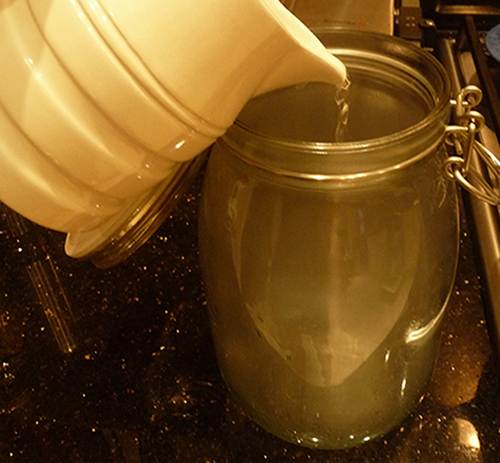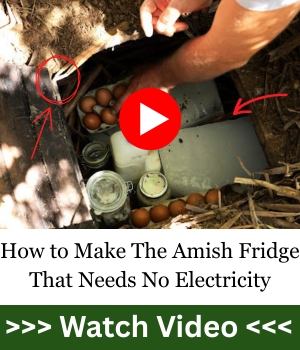Although knowing how to produce or procure clean water is vital in an emergency situation, canning water is often overlooked. It shouldn’t be. Sure, bottled water is easy to come by and pretty cheap to purchase, but not everyone is convinced that long-term storage in plastic containers is completely safe and others aren’t crazy about the environmental aspect either.
How to Can Water – Put Empty Jars to Good Use!
There’s also the fact that many preppers have an impressive store of jars ready to be used, so why not keep them filled with water? It doesn’t take up any extra space, and you can always use the water if you need the jar!
If supplies are cut, then you simply cannot have too much clean drinking water. You also need water for sanitation, rehydrating dried foods, cooking and cleaning, alongside the ration of 1 gallon of water per person, per day that should be considered the absolute minimum.
It’s sometimes said that canned water can taste a little ‘flat.’ True enough, but that can be easily remedied by removing the lid, pouring out a little water, then giving the jar a good shake. Another way of aerating the water is to simply pour it into a clean jar, then back into it’s original jar a couple of times before drinking.
Here’s what you need:
Jars! As many as you hope to fill and store. Don’t worry too much if they are reused mayonnaise-type jars either. Although preserving jars with sealing rings are the touchstone, for water canning, as long as you get a good seal, then you’re fine.
You also need water, your canner or stockpot and a ladle or jug to fill the jars.
Method:
- Clean out those jars thoroughly and run through the hot cycle of the dishwasher if you have one, using the jars when still hot. Otherwise warm the jars in an oven heated to around 175 degrees.

- Meanwhile, take your biggest stockpot, canner or saucepan and boil up some water to fill the jars. You know how many jars you have to fill, so work accordingly.
- While the water is coming to a boil, prepare a safe place to store the filled jars until they’ve cooled down by spreading out a double thickness tea towel or cloth somewhere they won’t get knocked over (they’ll be placed upside down initially).

- Keep the water on a rolling boil for 10 minutes, topping up the water level a little if necessary.

- Working with the hot jars, one at a time, keeping the rest warm in the oven or dishwasher, fill each one with boiling water to around ½ inch below the rim, using a ladle or jug.

- Taking good care not to burn or scald yourself, and using thick rubber gloves if it helps, screw the lids back on or reseal and place upside down, on your prepared cloth, and leave until completely cool.

- Once cool, turn the jars the right way again, and check that the lids have sealed nicely. If you’ve used metal, reusable-type lids, you can check if you have a good seal by trying to ‘pop’ the center of the lid. If it stays solid, it’s sealed. If it ‘pops’ in and out, then use the water straight away and start again.

How to Can Water – Shelf Life and Storage
Some people add a little salt, sugar or even a drop of bleach to the water to ensure a long shelf life.
A good habit to get into is to make up a couple of jars of water every time you use your canner for other purposes, then just add them to your supplies.
Canned water should last for 6 months to a year (arguably even longer) if stored in a cool, dark place. As with most canned items, don’t store in direct sunlight. Mark up the jar with the date you canned it and enjoy knowing that you’ve just made a truly canny addition to your stores!
You may also like:
If You See This Plant, Whatever You Do Don’t Touch It!
An Insanely Effective Way to Build a 5 year Food Stockpile (Video)























I wonder how many realize metal jar covers are painted on the inside.PAINTED!,so when you add heat ,the chemicals go into your,food,water,etc
What brand of canning lids are U talking about? …. the only “paint” on the major brands is the inking of their brand label on the outside of the lid – canning lids have to pass FDA regs and “paint” wouldn’t be allowed …
What a great idea! All those empty jars in the garage are going to be put to use! Thanks :c)
Hello Claude Nelson,
I’m kinda scratching my head here, I think that canning the water is a good idea if you can stay “bugged in”. I have couple of question, first why is it you believe that the water that is canned in this fashion would have a shelf life of 6 months to a year?
Second why do you think it would need to be stored away from sunlight if I used ball jars and lids?
I ask these questions because there is much confusion about water and its treatment.
Water doesn’t have an expiration – fresh water from a well /aquifer is eons and eons old …
Potable water containered in a clean vessel with no contaminating factors is good to go for a lifetime ….
Can you please explain why you leave 1/2 inch of air at the top rather than fill the jar all the way to the top? I thought that an objective of canning was to remove all the air.
Ted,
In food canning the air gap differs with the food processed, as the canning process caused\s expansion in the jar, the air gap at the top allows for some air to be pushed out while it’s “cooking” while keeping the lid seal from contaminants. In this case, because the article says to boil the water, and then invert the jar, the air gap trapped inside the jar acts as a compressible area until the cooling begins, the trapped air pocket is also exposed to the high heat and would most likely be sterilized of any air-borne bacteria during the cooling process since no additional processing is involved.
Hope that helps.
I can buy distilled water for 48¢ a gallon. I checked my electric usage and at 48¢ a gallon, that is pretty close to what my electricity cost is for boiling water to sterilization point. I store distilled water in 2-liter bottles that contained selzer water which I like to drink in lieu of soda water. I store the filled 2-liter bottles in empty wine cases. I can get 5, 2-liter bottles in a wine case. I don’t worry about the date on the water. The bottles are sterile from the factory. Selzer water is plain water with carbon dioxide added. Distilled water is pathogen, heavy metal and organ-phosphate free. The wine boxes protect the water from light and help moderate the temperature. In addition, storing the bottles in boxes allows them to be stacked. While there may be some danger of petrochemicals leaching into the water from the PET bottles, in my view, while reasonable minds may disagree, I think I will have far more severe problems to occupy my mind than the possibility of minimal amounts of petrochemicals in my water.
If one is worried that passers-by will notice a large quantity of wine stored in your garage, masking the writing on the boxes with paper shipping tape eliminates that problem. Then all you have is a stack of plain brown boxes stacked in the garage which could contain anything.
You are lucky then – I live where it freezes in the winter and gets over 100 degrees in the summer and I’d have to leave a lot of space to the bottles to accommodate for expansion of I stored my water in my garage. I wish that I could. It would save a lot of space. I do can my water in glass canning jars and I believe they can only be stacked 3 boxes high due to the weight of the water. The wine bottles may be able to handle more weight.
Predictive strikes again! That should be organo-phosphate. I didn’t notice that predictive corrected my typing. I hate it when a machine thinks it is smarter than I.
Well over 8 months ago, I sanitized and tilled COSTCO milk containers….14 of them. I sanitized the water using 8 drops of CLOROX to each gallon. A sample is drawn every 2-3 months to check for clarity and odor. I currently have 20 gal stored in my garage whee it is cool
Be aware that milk jugs are normally biodegradable …. which means at some point all your precious water will leak out on the garage floor. Better to invest in “blue” water containers that are designed to last.
Farmer: It depends on where you are as to whether milk jugs are biodegradable. In my area, milk jugs are #2 HDPE. Not biodegradable. Some areas’ jugs are dissolvable by gasoline. Mine aren’t. They hold gas just fine.
I’ve used milk jugs (properly cleaned, of course) to store water in for months and over a year, without breakdown or the much-feared bacteria.
I have safely stored 1 plus year old tap water in my freezer in old gallon milk jugs. Large blocks of ice improved cooling efficiency as a full freezer is easier to keep cold…and in the loss of power, it extends the timeframe before frozen food loss will occur, by keeping the freezer cold enough to keep things frozen.
Water doesn’t really spoil, so clean water might not taste “fresh” but would be effective still for brushing teeth, wound washing, bathing, and sufficiently clean to sustain life. Chlorinated water doesn’t require boiling to safely store in a clean container….sooooo, I won’t be doing any of this canning business. No babies to make formula for.
I would like some input on 5 gallon bottles of Arrowheadwaterdelivery.com they are offering first time buyers to purchase their product for $3.00 per 5 gallons.
I can purchase 20 or 30 X5gal at a considerable saving than buying 5gallon jugs or 50 gallon barrels. Store in dark cool location and have a good supply for drinking. Maybe seal around factory lids as an extra precaution.
Any ideas?
If the water is sterile, put into sterile containers, why would anyone add sugar or salt to it? If you want sweetness, why not add sugar after the water is opened? Or why would you feel the need to add chlorine? Chlorine is not a healthy nutrient, although it is what is readily available if the water’s purity is doubtful.
Water does not need to be canned. As long as you use a lid that seals (does not leak if turned on side), water will be keep. It does not expire. Milk should not be used to store anything edible including water. They break down and start leaking very quickly. Also, they absorb milk and it cannot be removed by any method,
Plastic milk and fruit juice containers seem to be particularly difficult to thoroughly clean, even with very hot soapy water. If you let the jar sit for a couple of hours with the life on and then open it and sniff the jar you can smell the milk or fruit juice.
I have found that about 50% of the lids on milk containers are not water tight after the seal has been broken and the lid taken off the jug. I store water in 64 oz. milk jugs to use as ice in my ice chest and I always check for leaks before I freeze them. A surprising number of them leak and I don’t use them. I don’t use the water, I just put the jugs back in the freezer for the next time.
If push comes to shove and I must absolutely, positively use the water in them, I figure I will give it the old ten minute boil routine before I use it which should kill any nasties in the water. I won’t take any chance with just pasteurizing the water but use the old tried and true ten minute boil.
I’ve been using Diet Coke or white vinegar plastic bottles, rinsing them with clean, soapy water, then filling with RO water from my tap. I will boil it if and when I have to use it…or use it for pet water.
At Winco, I found a 5 gallon water bottle they were selling for $7 plus change…bought it and will fill it with my RO water from kitchen tap along with some Clorox drops.
This is in addition to my cases of bottled water. I am close to having a months supply for me and one for the animals.
In my backyard, I have a tub and a trough I can fill up ASAP when needed as well as some buckets and my inside bathtub. That can all be cleaning water or pet water if needed. Or drinking water if filtered and boiled.
I am experimenting with gathering dew water overnight and running it into a container…I hoping to find a way to get a pint of water a day doing this. It will have to be treated or filtered though. That water can help keep some of my edible plants going. People in the desert have rebuilt gardens n started farms this way…if we get some sort of weather fallout, it may affect that though.
I would rather relay on the boil method or Clorox method…don’t want some nasty giardia or the like getting me sick.
But…I live an hour from LA and feel I need to not stay here if something long term happens, my bug out place is a 4.5 hr drive away to a friends house on 27 acres in a remote area. Being this close to LA, I am CERTAIN the masses will head this way when they get desperate. So I will have to pack up and leave…
I have read that old time sailors would put a piece of silver in their water barrels to prevent bacterial problems, why not add a capful of colidal silver to your water containers?
Several points I want to share:
I save my glass wine bottles and when I buy wine by the case, I by gal. jugs. The wine is cheaper in gal. containers and comes in dark green glass. Ideal for storing anything light sensitive. I put the bottles back into the case. Gal jugs come with screw on lids. If you use regular wine bottles that come with corks, you can buy new corks at Wal-Mart by the bag. I have well water which is pure and filter by nature’s gravel and sand. I don’t put anything in the water to treat it for storage.
Secondly, I am curious where you got the instructions to turn hot jars upside down? I learned the hard way when I was first canning food that when I tried that, the air in the jar expanded and blew scalding food out the bottom of the jar. It literally exploded. I never turned a hot jar upside down after that. Why not just can it in a water bath canner and use the method for canning juice. (10 min. at a rolling boil) and don’t touch them till the jars cool down.
Ooooooh! You must have had a defect in the jar for that to happen. How freaky!
Do like in the old days they used silver in wooded barrels as antimicrobial, They just do not say how much silver per gallon. Does anyone know this answer?
There were lots of remedies in the “old days” that were actually harmful. Doctors used to use mercury to cure syphilis lesions. Yeah, it killed the bacteria. It also eventually killed the patient. That’s really a Hobson’s choice, die of syphilis or die of mercury poisoning? Is there a third door? While I haven’t read up on the success rate of mercury application for actually curing syphilis recently, my recollection is that it never actually did “cure” the victim of the disease, merely masked its symptoms.
There are some folk who swear by the antiseptic properties of silver. I think that comes from the old practice of putting silver nitrate in the eyes of newborn babies to protect their vision from venereal disease the mother might have in her vaginal tract. Women infected with gonorrhea generally don’t exhibit external symptoms. Gonorrhea infects the mucus membranes, including the eyes. A baby born with gonorrhea of the eyes would become blind in short order.
So while some on this list swear by silver in a variety of forms and swear that a silver dollar in a 55 gallon container will make the water just a pure as can be, there are an equal number who really question whether silver dollar in a barrel of water will eliminate all the nasties that can cause the bloody flux which is the olden days term for fatal diarrhea.
You must bear in mind that many more people and especially children in the “good ole days” died of diarrhea than do today. Part of that is because we are generally drinking cleaner water than existed in prior centuries.
The surest way to treat water is to boil it. It isn’t really necessary to boil it for ten minutes at a roiling boil. That wastes fuel and time. If you do boil it for that length of time, you most assuredly will kill any living organism on earth that inhabits water. Actually, if you had a large enough container, you could kill a Kodiak brown bear if you boiled it for ten minutes. Not only kill the bear but also cook it thoroughly enough to kill any trichinosis larvae it might have.
That is the tried and true method proven over long periods of time for sterilizing water. There is no guess work involved. One needn’t worry about expiration dates or chemical strength of sterilizing chemicals nor the residual taste of sterilizing chemicals. Boil it! Boil it! Boil it! Simple and sure.
LCC,….. been following you comments on several pages, articles & topics. YOU ARE a genius at this,……… mostly! My Grampa also told me about silver, and even ‘modern medicine’ uses it is cases where ordinary antibiotics cannot extinguish the superbugs we have today,…… Yes, there are limits, but it also allows variants to be used that may not otherwise be considered. KMNO4 (potassium permanganate) aka: Pot-perm, can also be used,…..and for many other reasons. It not only sterilizes water, but (depending on concentration – so be VERY careful when using) it can also be used medicinally (external) for many things, including athletes foot, would cleaning, etc,……something that has many uses & takes up so very little space,…..
“wound” cleaning,……… gotta love autocorrect!
Whenever canning I may have empty space. that is utilized with jars of filtered water and canned along with broths or meat. You will be surprised at how many there are after a few loads.